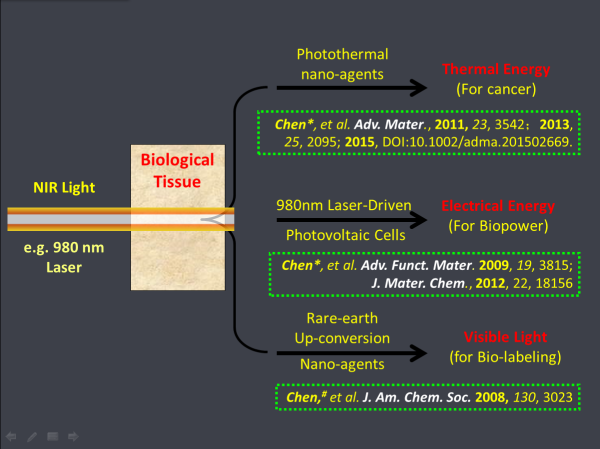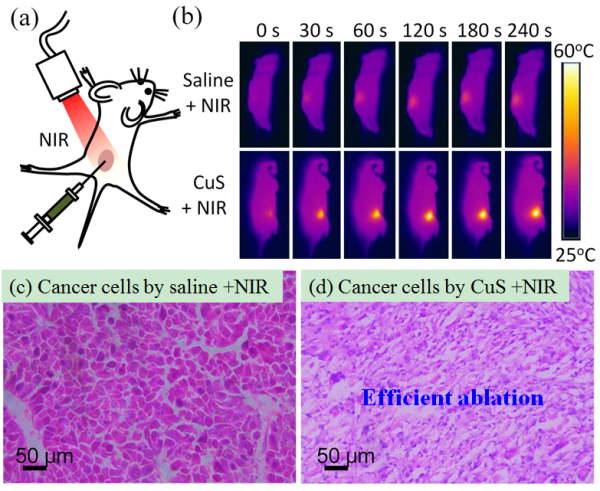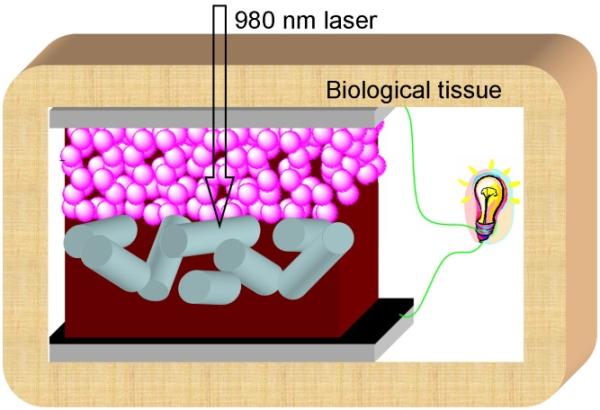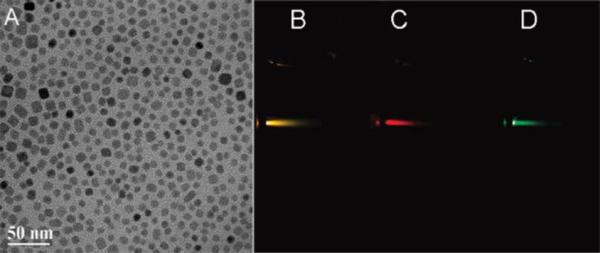
The life science and medicinecannot develop without novel technologies and methods. Novel analytical and therapeutic methods have attracted much attention of scientists.Among them, the use of near-infrared (NIR) lasers as excitation source is one of the most promising one, due to their deep penetration in organism.When NIR lightis used for biomedical applications,biological tissue cannot absorb it effectively. As a result,there should be a kind of ‘smart’nano-materials or devices to absorb and convert NIR light energy into signals or other forms of energy needed.Our group aims at developing novel materials and technologies that can absorb NIR light in organism and convert it into other forms, including NIR-thermal conversion for cancer therapy, NIR-electricity conversion for biopower and NIR-visible up-conversion for bio-labeling. Those three technologies correspond to three NIR-driven nano-materials and devices: photothermal nano-materials, 980nm laser driven photovoltaic cells and rare-earth up-conversion materials.

.1 NIR-Thermal Conversion for Cancer Therapy.
Cancer has been one of the major threats to the lives of humanbeings for centuries.For cancer therapy, several traditional techniques have been well developed, including surgery, radiotherapy, chemotherapy, immunotherapy and traditional Chinese medicine (TCM) therapy, etc. However, these techniques also exhibit some disadvantages, such as harming healthy cells, destroying the immune system, resulting in an increased incidence of secondary cancers. As a minimally invasiveand potentially effective treatment alternativeto conventional approaches, photothermalablation therapy (PAT) hasattracted much interest. In a typical process of PAT, NIR photothermal agentsshould be injected into tumors. Then,the tumors are irradiated with NIR laser.The photothermal agents in tumorsabsorb NIR laser and convert it into thermal energy, thus heating the tumors. As the temperature goes up (>42 °C), tumors can be destructed by thermal ablation.A prerequisite for the developmentof NIR laser-induced PAT is to obtain biocompatible, targeted photothermalagentswith high photothermal efficiency.In our group, we focus on the development of semiconductor photothermal nanoagents, such as CuS and W18O49. In order to optimize the therapeutic effects, we further combine photothermal agents with imaging agents or drug delivery systems for developing the imaging-guided photothermal therapyand/orsynergisticchemo-photothermal therapy.

.2NIR-ElectricityConversion for Biopower.
Nanotechnology holds the promise of using wireless biologicalnanorobots for in-situ and real-time in-vivo diagnosis andtherapeutic intervention of specific targets.The most effectiveway to keep these nanorobots operating successfully is to establishthe use of electrical sources. These electricalsources should be continuously available inthe operational biological environment,such as inside the human body, for longperiods.It is well known that near-infrared (NIR) light in the wavelengthrange from 700 to 1000nm is absorbed less by biological tissues;the typical penetration depth of 980-nm light can be severalcentimeters in biological tissue.Our group aims at developing NIR-laser-driven photovoltaic cells for the power supply of biological nano-robots.

.3NIR-Visible Up-conversion for Bio-labeling.
Conventionalfluorescent materials usually emit one lower-energyphoton after absorption of a higher-energy ultraviolet (UV) orvisible photon.However, neither ultraviolet light nor visible light can penetrate efficiently into organism. To solve this problem, thedevelopment of alternativeup-converting rare-earth nano-phosphors hasattracted a tremendous amount of attention.Up-conversionis a process where low-energy light, usually near-infrared or infrared, is converted to higher-energy light (UVor visible), through multiple photon absorptions or energytransfers. Our group utilizes rare-earth doped up-conversion nanoparticles to convert NIR lights into visible lights for bio-detecting and bio-labeling. And we also explore their applications in cancer optical therapies.
